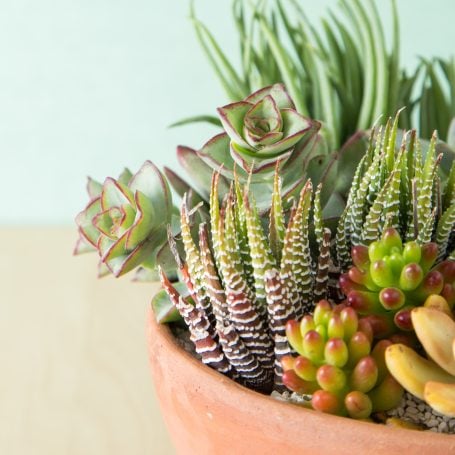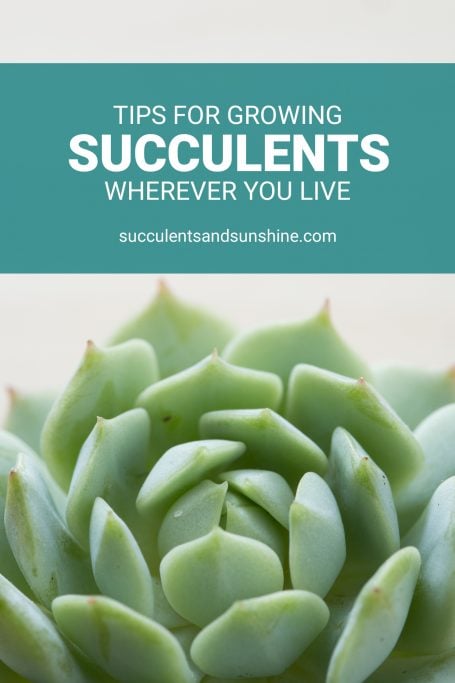Succulents are fashionable plants with attractive shapes and hues, and they do not require much water. Nonetheless, not all areas are suitable for cultivating succulents.
I’m here to provide you with the basics so that anyone, no matter their location, can enjoy growing succulents.
Many individuals are interested in cultivating succulents but lack the optimal environment for them to thrive. I’m one of those people as well!
When you buy something by clicking a link on this site, we may get a commission from the transaction. This commission doesn’t add to the cost of the item, and it helps us keep providing you with free content.
For those who find succulent gardening easy, this guide will provide further insight into how to cultivate these plants in less than ideal conditions. For those who find it a challenge, this guide will provide the necessary steps to help you master the art of succulent gardening.
Some people may claim that it is difficult to kill succulents, but this statement makes me uncomfortable. Similar to any other type of plant, it is necessary to understand how to properly care for succulents in order to ensure their survival.
The great thing about succulents is that they are generally quite hardy and easy to maintain, but there are certain areas or climates which might require extra attention to ensure they stay healthy.
In this article, I’m going to provide you with a straightforward guide on how to care for your succulents in the most efficient way.
Sounds great! Let’s get going!
Table of Contents
Pick the right plants
I have come to understand, through the unfortunate demise of numerous succulents, that some types of succulents will flourish in the interior of my home, while others will do best when kept outdoors on my porch. However, due to the climate in my area (Zone 5), most succulents will not survive the cold temperatures of winter outdoors.
In other words, due to the lack of natural light in my home, many succulents may not thrive indoors.
If you are cultivating succulents outdoors, it would be a good idea to research the amount of sunlight they need. Although the instructions of many succulents recommend “full sun,” they may not be able to withstand the heat of direct sunlight all day if temperatures reach 100 degrees Fahrenheit (though some varieties can).
Even if they can adapt to bright sunlight, if they have been bought from a nursery where they have been kept in a greenhouse, they will usually require some adjustment time.
If you’re just getting started with succulents, you can get the jumpstart you need by signing up for my free Succulents for Beginners course. Click here to get started and get growing!
You should note the frost tolerance of your succulents. For those of us living in cooler climates, Sempervivums and stonecrop Sedums are the most reliable outdoor varieties. I’ve enjoyed making outdoor planters and arrangements that stay in good condition throughout the year.
For those living in zones 9 and above, you have a wealth of succulent options to choose from. Most succulents thrive in zone 9 and 10 climates when grown outdoors.
If you’re cultivating succulents indoors and lack an abundance of natural light, then you’ll need to find varieties that can tolerate low light. Haworthias and Gasterias are generally ideal for these conditions.
I’m really beginning to like Sansevierias; they require very little light or water.
If you don’t have a grow light, it’s best to avoid most kinds of colorful succulents, as they tend to become spindly and elongated as they search for more light.
Generally, succulents with vibrant hues, such as Sedum nussbaumerianum, need ample sunlight in order to keep their color. Conversely, succulents with a natural green hue are better suited for indoor environments.
If you have a tendency to give plants too much water, look for succulents that are tolerant of or require more water. I personally have found that Portulacaria afra, with its thin leaves, needs to be watered more often. Other succulents that need more water are Crassula arborescens undulatifolia and Aeonium ‘Zwartkop’.
Alternatively, succulents like Graptoveria ‘Fred Ives’, Pachyveria glauca, and Aloe brevifolia, which are very plump, can last for extended amounts of time without being watered. Additionally, cacti like Mammillaria rhodantha and Mammillaria gracilis fragilis are also very capable of enduring long dry spells.
Are you understanding what is happening?
If you want to make the most out of your succulent garden, it’s important to select the right plants. My Succulents for Beginners course can provide you with all the information you need to pick the best succulents for your area. Sign up now and start learning!
I’m here to assist you in finding out which type of succulents you own by providing you with information in this post.
Tweak your soil materials
In hot and humid climates, soil is essential for avoiding decay, while in dry conditions, it is essential for maintaining moisture levels and keeping succulents healthy.
My suggestion for creating your own succulent soil that drains well is to mix together peat moss, perlite, and coarse sand in equal parts. Alternatively, you can purchase a specially formulated succulent soil mix that is designed to provide superior drainage.
If you have a tendency to over-water or live in a humid climate, I suggest planting your succulents in pumice alone. This material is ideal for these conditions and will help ensure that your succulents thrive indoors and outdoors in containers.
I am aware of many successful succulent growers who opt for pumice as their soil medium, due to its ability to hold some water yet also dry out quickly. Bonsai Jack offers a high-grade pumice with 1/4-inch particles, but you can also find it in most nurseries.
Rather than becoming frustrated with the need to water succulents often, it’s important to remember that they are drought-tolerant plants, so they don’t require as much water as other plants. Nevertheless, they still need some water to stay healthy, and having to water them every other day is not ideal.
Coconut coir is the ideal choice for hot and dry climates or soil that tends to dry out quickly. This medium will help retain more water than a peat-based potting soil but still allow for good drainage, so your plants will never suffer from overwatering.
Choose a great pot
Using terra cotta can be beneficial for novice succulent owners, as it is a porous material that allows for good air flow to the roots. This means that the soil will dry out faster, making it easier to prevent overwatering.
If you live in an area that is hot and arid, terra cotta may not be the ideal material for your pots. Ceramics, however, are a great option for most climates and you can find a wide range of pots to choose from on sites like Mountain Crest Gardens and Etsy.
I strongly suggest that you invest in a planter with a built-in drainage system. This is a great idea for novice succulent growers, as it will save you a lot of time and effort.
If you are new to growing succulents, start off with a simple container such as a glass bowl which does not have drainage. Once you become more experienced with caring for them, you can try using more creative containers.
Accept death and less than perfect succulents
In the end, it’s important to accept that you could fail in growing some succulents. Plants may die, and that’s just a natural part of the experience. Make sure to gain something from each unsuccessful attempt, so you can do an even better job taking care of your next succulent.
I understand that cost can be an issue, but luckily succulents reproduce quickly, making it easy to get more by exchanging cuttings or leaves with a friend. Instead of getting a bouquet of flowers, you can even ask your partner to get you some succulents as a gift to increase your collection.
Experiment
If you take away anything from this article, let it be that it is perfectly acceptable to experiment. I myself have used a lot of my own experiments to form the basis of the information I share on my website.
I begin by delving into the background material on my subject, then I try out my theories through practical experimentation. My plants are constantly being subjected to experiments, allowing me to gain more knowledge as I go.
I understand that succulents can be costly in certain areas, but if you’re willing to take a chance and try, you’re more likely to have success. If you’re just starting out, you can take my free course, Succulents for Beginners, to familiarize yourself with the basics of succulent care and give yourself the best chance of success.
Although all succulents require the same fundamental care, the conditions of every living space and growing area are unique. Aspects such as natural sunlight, containers and soil, and other environmental factors will affect the wellbeing of your succulent–so take the standard directions for growing succulents and modify them to fit your situation.
It’s important to remember that what works for one person in one place may not be successful for someone else in a different location. Therefore, it is important to be flexible and adjust the rules to fit your individual needs and situation.
I firmly believe that anyone can successfully maintain succulents no matter the climate they are in. This post has provided some useful advice for customizing the care of succulents to fit your specific growing environment.
In order to achieve successful gardening, it is essential to have the right combination of plants, soil, and planters, as well as the willingness to perform some trials to determine what works best for your plants.
You’ll gain more in-depth knowledge of succulents in the Succulents for Beginners course. Get access by clicking here.
FAQ
How do you encourage succulents to spread?
Trim the leaves of your succulent plant, twisting them off at the stem. Discard the stems that have been removed. Prune back any spindly growth to promote new growth.
Where is the best place for succulents to thrive?
Put the potted succulent in a spot where it will get lots of sunlight. Consider a spot near a south- or east-facing window, as most succulents need around 6 hours of direct sunlight each day. Without enough sunlight, your succulent may become stretched or lanky.
What is the best potting method for succulents?
For succulents to thrive, their potting soil should have an open, airy texture that allows for good drainage. This means it should contain less organic matter than standard indoor soil mixes, with plenty of sand or perlite and pumice added to create a light, grainy consistency.
Can you plant succulents straight into the ground?
If you would like your succulents to thrive outside, you can put them in the soil, in containers, or a combination of the two. When you decide to bury them, make sure to give them a six to eight inch layer of soil meant especially for succulents.
Is it better to plant succulents in pots or ground?
Succulents, when given the room to do so, will send out their roots to search for nutrients, and this is why they tend to be easier to maintain and hardier when planted directly in the ground compared to those grown in containers. Furthermore, they are usually less troubled by small pests like mealybugs, aphids, and scale.


